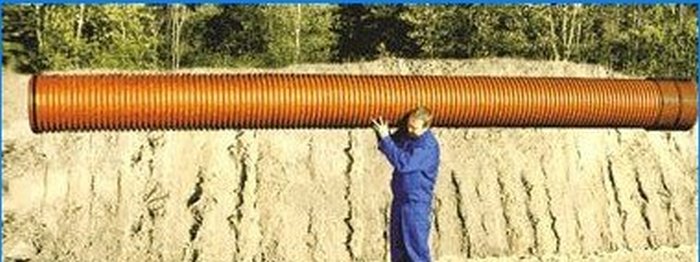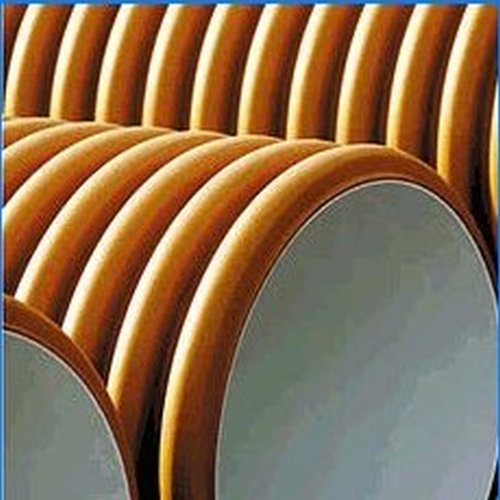From a conversation at an exhibition 10 years ago:
– Tell me what is it?
– Plastic pipes for cold and hot water supply and heating systems…
– Can these straws withstand hot water??…

10 years ago the answer seemed strange to many people, but today the question looks strange. We are all so accustomed to the new plastic piping systems, even though it has been so little time since the start of their operation. But scientific and technical progress is gaining more and more acceleration and the introduction of new technologies using the latest materials no longer surprises anyone.
Today there is a lot of information on the use of various types of plastic pipelines for internal engineering systems, including for sewage systems.
But what can manufacturers of plastic pipes offer us for completing outdoor piping? Currently, in the construction of external pipelines, the use of PE polyethylene (for cold water supply) and PVC polyvinyl chloride (for sewage) is widespread..
Until recently, the use of PP polypropylene for external sewerage systems was economically inexpedient due to the high consumption of material, since the main requirement when using plastic pipes for external sewerage systems is the required value of the ring stiffness.
The main disadvantage of plastic pipes compared to metal and concrete pipes is their inability to withstand large horizontal loads. This greatly limited the scope of application of plastic pipelines, because in a free-flow system, the slope of the pipeline is of great importance, as a result of which a large “deepening” of the route occurs in long sections. In addition, when pipelines pass through roads and loaded sections, it is necessary to lay them in casings or special sleeves, which leads to an increase in the cost of work, especially when laying pipelines within the city. Previously, this problem was solved by increasing the thickness of the pipe walls, which led to an increase in the cost of materials. But in recent years, the development of a polypropylene piping system with a profiled double wall has been very interesting..
Recently, similar pipeline systems have appeared on the Russian market under the POLYTRON K2-KAN brand. POLYTRON K2-KAN pipes are produced by continuous coextrusive stamping. This process proceeds as follows: two independent one-coil systems form in the plane a polypropylene granulate (of two different colors, but with the same properties), fed to the head, which simultaneously forms them along a common axis, and thus two pipes are modeled. The inner tube has a smooth wall, and the outer tube has a corrugated wall formed by a special pulling device. Both of these pipes are connected to each other during the molding process by pressing, creating a two-layer, well-welded wall at the joints (the connection occurs at the molecular level, providing a monolithic structure). The outer layer of the pipe is orange-brown and the inner layer is light gray.

What is new in the design is that the outer wall has additional ridge reinforcements at the top of the low wide rib, which perceive the concentrated point loads directly on the outer wall of the pipe, deforming it, but preventing deformation of the inner wall. Due to this wall structure, with a low weight of the pipe, it is possible to ensure its high perimetric strength (ring stiffness is equal to SN = 8 kN / m2, which corresponds to pipes of a heavy type), which makes it possible to use these pipes for laying in places with increased loads. Those. used for the construction of sewerage networks, laid at a depth of 0.8 m to 8 m on sections without loads, as well as under roads with a maximum dynamic load of 11.5 tons per vehicle axle. It is necessary, especially at high loads, to properly carry out work on sprinkling the pipeline and its correct sealing, so that there is no possibility of excessive deformation of the pipeline..
In general, energy costs and the amount of raw materials used in the production of pipes with a profiled wall are approximately 40-50% less compared to the production of pipes with a smooth wall, which significantly reduces their cost.
In the production of profiled pipes “POLYTRON K2-KAN” a block polypropylene copolymer (PP-b) is used. Polypropylene is lighter than polyethylene, has greater tensile strength, greater thermal stability and is not subject to stress corrosion. The operating temperature range for polypropylene is from -20 ° C to + 110 ° C, which allows the installation of pipelines at negative temperatures and its operation at elevated positive temperatures. In addition, polypropylene is characterized by a higher shock resistance compared to polyethylene and PVC, so the pipes are much “easier” to withstand the difficult conditions of transportation and installation. At low temperatures, PVC materials become very fragile, as a result of which there is a large percentage of defects due to chips on products. Microcracks that appear during storage and installation, during the operation of pipelines, contribute to the infiltration of the transported liquid. Another positive quality of polypropylene is that this material, like polyethylene, is characterized by greater resistance to abrasion among the materials used for the production of sewer pipes (concrete, cast iron). This is very important because sewage contains a large percentage of suspended solids.

Polypropylene is a very light material, so the installation is quick, without the use of heavy equipment. And the estimated service life of the POLYTRON K2-KAN pipelines is about 100 years. Polypropylene has a high chemical resistance, which makes it possible to use PP pipes not only for the construction of sanitary, industrial, storm and general purpose networks, but also for industrial pipelines that can be laid in soils contaminated with chemicals (for example, landfills, industrial waste storage , in the development of oil and gas fields).
Those. polypropylene is a material, the combined properties of which ensure the best quality of sewer pipes, which explains the dynamic growth in the use of polypropylene for the production of sewage systems. POLYTRON K2-KAN pipes are about 3 times lighter than PVC or PE pipes with a smooth wall, 15 times lighter than ceramic ones, and 20 times lighter than concrete ones. Therefore, the installation of the “POLYTRON K2-KAN” systems presupposes a saving in labor intensity by about 20-30% in comparison with similar systems made of other materials. Another advantage of POLYTRON K2-KAN pipes: they have a nominal size (DN), which is actually the inner diameter of the pipe (DN = ID). This means that the nominal size specified by the manufacturer is the clear pipeline size and allows designers to use it for hydraulic calculations. Typically, in such systems, the nominal size is the outer diameter (DN = OD), which, with the same pipe size, actually reduces its flow area. Those. pipes “POLYTRON K2-KAN” with the same diameter have a significantly larger internal section in comparison with similar pipes.
The wall roughness coefficient when laying external free-flow sewage systems is one of the main indicators, because it allows pipelines to be laid with a lower slope while maintaining the minimum self-cleaning speed. The relative value of the coefficient of roughness of pipes “POLYTRON K2-KAN” k = 0.00011 mm.

It can be argued that with such smooth walls, the slopes will be minimal. This is also facilitated by a system of bell-shaped fittings with minimal hydraulic resistance. In addition, the number of required control and inspection chambers for system maintenance is reduced. The possibility of laying pipelines with smaller slopes, and therefore at shallower depths, affects the cost of construction, because the volume of earthworks is sharply decreasing. This is especially true when working with heavy soils, when the choice between the construction of a pumping station and a gravity sewer system significantly affects the cost of construction..
Pipes K-2 KAN are delivered 6m long and are connected to each other using fittings. Each pipe is equipped at one end with a double-socket joint with an O-ring, and at the other end of the pipe with a second O-ring, which facilitates installation. Long pipe length virtually eliminates installation waste.
The pipes are cut using a conventional saw on site. The presence of fittings of various types and transitions to smooth pipes from various materials makes installation quick and reliable..
The K2-Kan pipe and fittings sizing system is designed in such a way that the O-ring connections ensure tightness at an additional pressure of 0.5 bar. There are practically no cases of exfiltration of effluents into the ground, or infiltration of groundwater into the pipeline. The tightness of the network is not affected by the bends of the pipelines under the influence of soil pressure, if they occur within the limits of up to 10% of the bend of the inner diameter.
It is also believed that the sockets of the fittings compensate for up to 30% of the deformation resulting from temperature changes..
Thus, the piping system is reliable, durable and environmentally friendly at the same time..
Author: Elena Pavlova, deputy. Head of the Marketing Department of CJSC “Egoplast”
Advertising

What measures can be taken to ensure the effective management and maintenance of outdoor sewerage systems, and how can we prevent potential issues such as blockages, leaks, and environmental contamination?
To ensure effective management and maintenance of outdoor sewerage systems, several measures can be taken. Regular inspections should be conducted to identify any potential issues like blockages, leaks, or damages. Implementing a preventive maintenance program, including routine cleaning and flushing, can reduce the likelihood of clogs and blockages. Well-trained and experienced staff should be employed to handle maintenance tasks promptly and efficiently. Implementing a comprehensive monitoring system with sensors can help detect leaks early, allowing for timely repairs. Regular maintenance, including regular cleaning of manholes, pipes, and other components, is essential. Additionally, community awareness campaigns should be conducted to educate individuals about the importance of proper waste disposal to prevent contamination and blockages. Providing proper waste disposal infrastructure, like separate bins for solid and liquid waste, can also contribute to effective management. Regular testing of water bodies near sewerage systems will help identify any potential contamination and take appropriate measures. Overall, a combination of proactive maintenance, regular inspections, awareness campaigns, and effective monitoring systems can significantly reduce blockages, leaks, and environmental contamination in outdoor sewerage systems.
To ensure effective management and maintenance of outdoor sewerage systems, regular inspections, preventive maintenance programs, well-trained staff, comprehensive monitoring systems, and community awareness campaigns are essential. Implementing these measures can help identify and address potential issues like blockages, leaks, and damages promptly. Regular cleaning, flushing, and testing of water bodies near sewerage systems are also crucial. Educating individuals on proper waste disposal and providing adequate waste disposal infrastructure can further contribute to effective management. By taking a proactive approach and implementing these measures, we can significantly reduce blockages, leaks, and environmental contamination in outdoor sewerage systems.
What are the potential environmental impacts of outdoor sewerage systems and what measures can be taken to mitigate them?